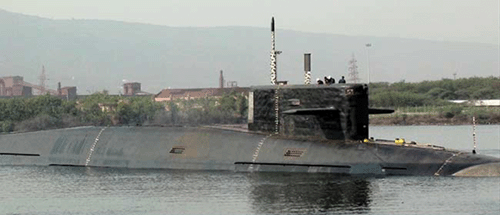IDR Blog
India's Nuclear Triad: Meeting the Deterrence Challenge

INS Arihant
INS Arihant, part of Indian Navy’s (IN) Advanced Technology Vessel (ATV) project at Visakhapatnam, and India’s first indigenous nuclear ballistic missile submarine recently became fully operational after completing its first deterrence patrol. This extended patrol capability adds to significant increase in deterrence and completes the nuclear triad with ability to launch nuclear weapons from land, air and sea. Commissioned in February 2016, the submarine can be deployed underwater for months and needs to return only for restocking and crew change.
Earlier IN has been operating and training on the Russian Akula-class leased nuclear submarine INS Chakra (without ballistic missiles) and was the basis of Arihant’s design. India also became a part of the elite club of countries, USA, Russia, China, France and UK, that possess nuclear ballistic missile submarines. “India’s nuclear triad will be an important pillar of global peace and stability,” Prime Minister Narendra Modi announced.
The Arihant submarine is powered by an 83 megawatts pressurized light-water, enriched uranium reactor, a prototype of which was built at Kalpakkam in 2006. The hull was built by L&T’s Hazira shipbuilding facility. Tata Power Strategic Engineering division built the control systems. The steam turbine was supplied by Walchandnagar industries. The consultancy for this project was provided by Russia. There are four vertical launch tubes which can carry 12 smaller Sagrika’ K-15 (750 km) missiles or four larger K-4 missiles (3500 km). Submarine launch of K-4 has still to be operationally tested. K-4 is crucial to achieve naval deterrence which still remains work-in-progress. The futuristic K-5 will have a range of 6,000 km. Also to keep the enemy at bay there will have to be at least 4-5 submarines for deterrence to be effective. That would mean significant cost and time. Also, the submarine element is much costlier than air and land elements. When submarines are deployed deep and far, there could be command and control issues related to nuclear weapons. Very secure and advanced communications systems with back-ups will be required; till then they may have to operate closer home.
The second Arihant-class SSBN, the INS Arighant, was launched in November 2017. The same is expected to be commissioned in 2020 or 2021. The sub will have eight missile tubes, twice those on the Arihant. It will also have a more powerful reactor and a slightly bigger overall displacement. In also has the ship-launched short-range Dhanush ballistic missile (Prithvi variant), with a range around 300 km.
Nuclear-armed fighter-bombers were India’s first and only nuclear-capable strike force until 2003 when the country’s first land-based nuclear ballistic missiles were fielded. Mirage-2000, SU-30 MKI and Jaguar fighters (subsequently Rafale) of Indian Air Force (IAF) are designed to carry and deliver nuclear weapons. These could be free-fall unguided bombs or missiles. The air bases have been have been assigned the nuclear strike role against Pakistan and China. The land-based nuclear weapons are deployed through the Indian Army using both vehicles and launching silos. They currently consist of the Prithvi series (150-600 Km) and Agni series of missiles, with a test range of 5,000 to 10,000 km. The supersonic BrahMos cruise missile has land, air, ship and submarine launch variants.
The air and land elements have a civilian component, mostly BARC scientists who will maintain, prepare and connect the nuclear warhead. In case of submarines, the warheads have to be pre-mated, the launch authority would be with the submarine captain on explicit orders. Weapons that have been mated will have electronic locks that can be used to unlock with due authorization. Accidental safeties are thus in place.
A key driver of India’s nuclear plans is the deterrence against Chinese nuclear weapons capability. China’s nuclear force is dominated by land-based missiles which include ICBMs, IRBMs, tactical ballistic missiles, and cruise missiles. The nuclear bomber force consists of Xian H-6 bombers modified for aerial refueling. China has an arsenal of about 250 nuclear warheads; China has no-first-use (NFU) policy. China currently has four active Type 094 (Jin-class) nuclear submarines with 12 JL-2 SLBM with an estimated range of 7,500 km. Eight more were to enter service by 2020. Chinese SSBNs with nuclear weapons on board have been frequently sailing in Indian Ocean.
Pakistan has a limited conventional submarine fleet essentially of French origin. With the test of the nuclear-capable, submarine-launched cruise missile (SLCM) – Babur-III, Pakistan claims to have a nuclear triad. Arihant becoming operational could force Pakistan to look for Chinese help to build its own nuclear submarines. Their current poor financial state may delay this exercise. Pakistan has a clear policy on first use of nuclear weapons against India, in case threshold affecting their integrity gets crossed. They are also developing Tactical Nuclear Weapons (TNW), that they think can be used against a massive Indian Army thrust. India’s stated policy for the response nuclear strike is that of massive counter-value/counter-force retaliation.
India is known to have 100-120 nuclear weapons. India believes that nuclear weapons are political weapons, not weapons of war-fighting. Their sole purpose is to deter the use and threat of use of nuclear weapons. India has a clearly enunciated NFU nuclear policy and a nuclear doctrine based on “minimum credible deterrence” with ability to withstand the first strike and have a credible nuclear response strike capability. Till significant numbers of submarines are built, India would need to bank heavily on air and land elements. With such military buildup among the three nuclear neighbors who have seen full scale wars and have constant skirmishes, there is a need to have confidence building measures (CBMs) in place bilaterally. There are some in Pakistani military who believe that in case of localized TNW attack by Pakistan, India may not respond with a full-scale attack thus risking a Pakistani second strike over its own cities. TNW are mainly employed against armed forces in the tactical battle area and therefore have lower threshold for use. These enhance the risk of unauthorized and accidental launches and are complex to deploy.
India’s current nuclear deterrence stance is not for proportional response which Pakistan has adopted to respond to deter a low-intensity conventional attack. India has clearly stated that once nuclear conflict is initiated, it would swiftly and inexorably escalate to the strategic level and India would respond with a comprehensive punitive nuclear strike in case deterrence fails. While the geographical ranges are easy to define, where must India draw its line in terms of numbers and yield of nuclear weapons for long-term credible deterrence against China needs to be evolved and defined.
India’s nuclear triad, therefore, still needs to be progressed to its finality for long-term deterrence.
Courtesy: https://southasiamonitor.org/news/india-s-nuclear-triad-meeting-the-deterrence-challenge/sl/28582




